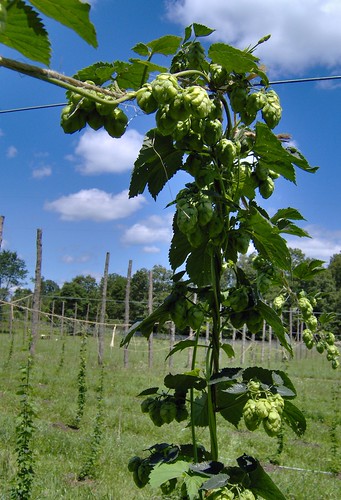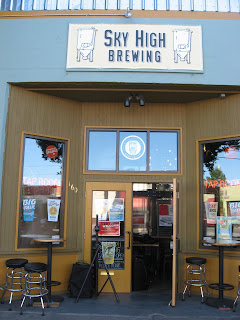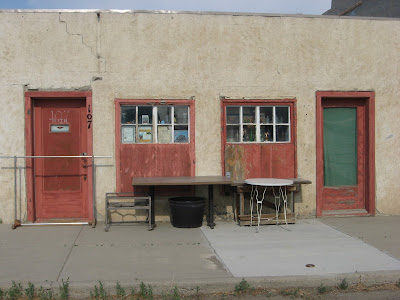There are worse places for a man who likes beer to find himself than in Oregon. Actually, there are few places better. Spending a few days in Bend, then taking the slowest, most mountainous road over the McKenzie Pass to Corvallis for a day, and then moving on to Salem for the natioanl gathering of BMW motorcycle riders, I found kindred souls. Several blues bands, a well-stocked beer garden (where I was recruited to serve as a bartender) and about 6,000 serious motorcyclists, many camping out, created just the atmosphere that my retired life needed to inspire further adventures.
 |
| Admit it. You knew this is what Oregon looks like! |
  |
| Roadside in the Willamette Valley |
|
 |
| Humulus lupulus-- hops! |
With a cooler climate than California, the gently rolling hills surrounding the Willamette are home to some of the best (and most expensive) Pinot Noirs in the world, as well as a high-quality Pinot gris. But to me, Willamette conjures up the tongue-bending wonder of hops, that delightful flower that adds so much interest and character to the various beers I enjoy. It seemed only right to take a few days to sample the fruit of the land.
 |
| Not a bad combination | | | | |
|
I discovered Oregon has 137 craft brew companies operating 175 breweries in 59 cities. It was a real task to plot out a course that allowed sufficient sampling while still balancing on two wheels. Bend, with a population of about 80,000, has 15 brewing establishments. I decided to completely avoid metropolitan Portland which has 69.


The Deschutes Brewing Company of Bend, Oregon is the fifth largest craft brewer in the country. They us no pelletized hops but only whole-flower, and they use about 3 tons of these little guys every month to make beers such as Chainbreaker White IPA and Fresh Squeezed IPA, a citrusy brew using mosaic, nugget and citra hops. Their Black Butte XXV limited release beer was available at the brewery when I visited. It was lyrically described as "Like the plot of some eerie mystery you can't put down." Makes you just want to take a sip, doesn't it? For the beer geeks, it uses millennium, cascade and tetnang hops, along with cocoa nibs, mission figs, medjool dates and sour wort.

I would hope to some day develop the palate to discern all the complexities of flavor and taste. I'm sure it would not only enhance my enjoyment of beer but also make me pay more for wine, which right now reaches its sensory ceiling at about $9.00 a bottle. At Deschutes, the "tasters panels" are created from volunteer employees who undergo over a year's training in discerning tastes. How this for moving beyond "bitter, sour, malty, sweet?"
 |
| Principled management...and free beer at the end of each shift |
|
 |
| Parked in front of Crux Fermentation Project, Bend, OR |
|


 |
| Boneyard Brwing Co., Bend, OR |
|
 | |
| Boneyard turned out to be my favorite in Bend |
 |
| Even strip malls have brewpubs in Oregon |
|
 |
Corvallis, Oregon | | | | | | | | |
|
|
 |
| Lava fields in the Cascade Range |
|
 |
Mechanic turned horseshoe sculpture artist: Pilomath, Oregon
 |
 |
| McKenzie Pass |
|
The McKenzie Highway over the coastal range of mountains west of Corvallis is a wonderful diversion. As I passed over the summit expending little more than the twist of my right hand, I watched dozens of professional bicycle racers competing in one of a week's events in the area, this one going through expansive lava fields and over the McKenzie Summit. US 20 ends at the Pacific Ocean in Oregon right in front of a motorcycle shop. Stopping seemed a necessity.
 |
| This was worth a stop |
|
 |
| Motorcycle contraption...long-time travel home to this old timer at the rally |

I'll be starting east on Sunday. Hope to follow the Oregon Trail. That should leave me in Independence, MO...which I don't think is very near Chelsea, MI. I better keep an open mind.
 My detour through Yellowstone took me off of the Oregon Trail for awhile but I rode south and picked-up US 20 which parallels a lot of the trail. I soon learned Route 20 could take me all the way to Chicago with not so much as one mile of interstate "slab." Looks like a way home!
My detour through Yellowstone took me off of the Oregon Trail for awhile but I rode south and picked-up US 20 which parallels a lot of the trail. I soon learned Route 20 could take me all the way to Chicago with not so much as one mile of interstate "slab." Looks like a way home!



































































